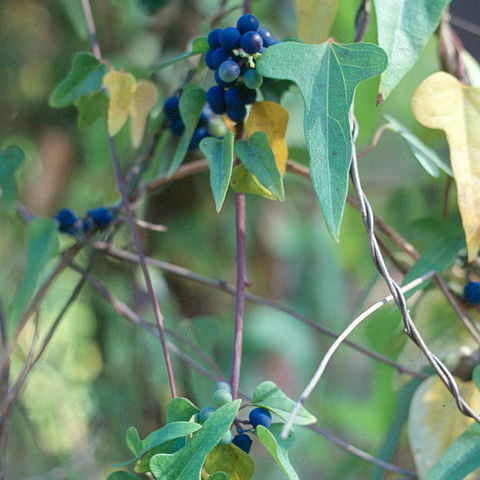Vines , twining or clambering. Stems green, apically tomentose grading to pilose or glabrate on older portions. Leaves not peltate. Leaf blade generally ovate to hastate or oblong, base cordate, truncate, or rounded, margins entire, apex mucronate; surfaces soft-pubescent or glabrous. Inflorescences axillary or terminal, racemes or racemose panicles; bracts minute (bracteoles). Flowers 3-ranked; sepals 6-9, ovate to elliptic or obovate, outer sepals glabrous or pilose to sparsely pilose abaxially, inner sepals glabrous; petals 6, free. Staminate flowers: petals to 2 mm, auriculate lobes at base inflexed over 6 stamens; filaments distinct; anthers 4-locular; pistillodes 36 or absent, glandular. Pistillate flowers: perianth similar to staminate; staminodes 6, poorly developed; pistils 6; ovary slightly asymmetrically pouched, glabrous; stigma entire. Drupes globose, glabrous; endocarp bony, depressed but not excavate, warty, ribbed. x = 13.
Woody vines, erect shrubs, or small trees. Leaf blade entire or lobed, not peltate, palmately veined. Inflorescences axillary or terminal, cymose or thyrsoid. Male flowers: sepals 6(or 9) in 2(or 3) whorls, imbricate, outer sepals smaller, inner sepals larger and concave; petals 6, apex 2-lobed, lobes divaricate, with basal reflexed auricles; stamens 6 or 9, free, anthers dehiscing with a transverse slit. Female flowers: sepals and petals as in male flowers; staminodes 6 or absent; carpels 3 or 6, style columnar, stigma reflexed. Drupes obovate or rotund, slightly flat, style scar near base; endocarp bony, horseshoe-shaped, abaxially verruculose or ridged; condyle with 2 distinct lateral chambers, each with a large lateral aperture. Seed horseshoe-shaped; embryo with radicle short; endosperm scanty; cotyledons linear and flattened.
Slender woody climbers, erect shrubs or small trees. Leaves not peltate, rarely lobed (in Mal. spp.). Inflorescences cymose or thyrsoid. Male flowers: sepals 6-9 in 2-3 whorls, the outer sepals smallest; petals 6, bifid or emarginate at apex, with basal inflexed auricles clasping the opposite stamen; stamens 6, free. Female flowers: sepals and petals as in male; staminodes 6 (in Mal. spp.); carpels 3 or 6, styles subulate, reflexed. Drupes curved with style-scar near base, obovate or rotund in outline; endocarp dorsally verruculose or ridged and with a curved aperture on both lateral faces. Seed curved almost into a ring, broad, dorsiventrally flattened; endosperm very thin; embryo with liguliform cotyledons.
Male flowers with 6 sepals, the 3 outer ones reduced, the 3 inner concave; petals 6, furnished at base with more or less fleshy inflexed auricles surrounding the stamen-filaments, often bifid or deeply emarginate at the apex; stamens 6–9, free; anther-thecae with transverse dehiscence.
Sep, pet, and stamens each 6; pistils 3 or 6, with entire stigma; fr flattened on both sides, the stigmatic scar lateral; stone thickened and rough on the margin for three-fourths of its circumference, somewhat excavated on the sides; woody twiners. 10, warm reg.
Female flowers with sepals similar to those of the male; base of petals much less inflexed; staminodes 6, linear-filiform or absent; carpels 3–6, subovoid and compressed, with cylindric style and recurved-spathulate stigma.
Male inflorescences of cymules which are either axillary and clustered 1–3-together, or solitary and arising from leafless branches, or grouped in ± condensed clusters on the cladodes;3 pedicels present or absent.
Prostrate or erect climbers or suffrutices; branchlets rambling, or reduced to cladodes.3 Leaves simple, various in form, entire or lobed.
Female inflorescences similar to the male or more simple or reduced to solitary or clustered flowers.
Drupes obovoid or flattened and rounded; the remains of the style visible near the base.
Seeds with scanty endosperm.

